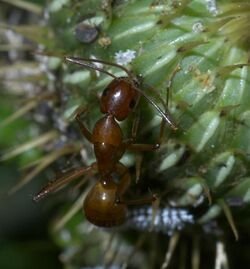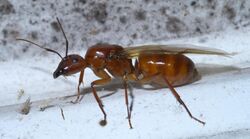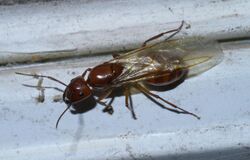Biology:Camponotus castaneus
| Camponotus castaneus | |
|---|---|

| |
| Scientific classification | |
| Domain: | Eukaryota |
| Kingdom: | Animalia |
| Phylum: | Arthropoda |
| Class: | Insecta |
| Order: | Hymenoptera |
| Family: | Formicidae |
| Subfamily: | Formicinae |
| Genus: | Camponotus |
| Species: | C. castaneus
|
| Binomial name | |
| Camponotus castaneus (Latreille, 1802)
| |
Camponotus castaneus, the red hazelnut carpenter ant, is a species of ant in the family Formicidae.[1][2][3][4][5][6][7] It is a primarily orangish-red ant in the family Camponotus. Its workers are usually around 8-10 mm, and queens around 18-20 mm. As with most Camponotus species, camponotus castaneus has majors and super-majors, usually appearing in the second or third year of the colony's founding, majors are usually 10-14 mm, with super majors being around 13-17 mm. Camponotus castaneus has a generalist diet, feeding on insects and carbohydrates such as honeydew, which is easily accessible. This ant is not a pest therefore you should not use pesticides against them. The ant has a smooth thorax and abdomen, with 1 node separating them.
Diapause (hibernation)
Similar with other Camponotus ants, Camponotus Castaneus will go into a hibernation-like state during the winter, called diapause. Though unlike other ants, they go into diapause very early, usually during the first cool days of fall, they stop foraging. Which is usually the reason they are not seen during fall or winter. In some hot areas, such as Southern Florida, they still go through diapause during fall and winter, regardless of the temperatures.
Development
Like all ants, Camponotus castaneus has 4 main stages, egg, larvae, pupa or pupae, and adult ant. The entire process from egg to adult ant takes around 35-60 days, depending on the environment factors, such as heat, food, and humidity.
Egg
The eggs are laid by the queen ant, which is around 18-20 mm, common with Camponotus ants. Eggs are very small, usually 1-3 mm, and look like white beads. They can take up to 1 or two weeks to hatch into the next stage, larvae.
Larvae
Once the egg hatches, it hatches into larvae, which is the longest stage before adult ant, taking a few weeks at least. These larvae need to be fed, and they are hook shaped, and they must be fed, unlike the eggs and pupae. During diapause, developing ants are usually kept at this stage. More on feeding in the social behavior section, during this stage is also when the gender of the ant is decided, whether it is a female queen or worker, or a drone (male ant).
Pupa/pupae
Once the larvae develops, it turns into a pupa, which depending on the species of ant, may be what is said to be "naked". Naked pupae look like pale worker ants that are clumped together. Camponotus castaneus however, does not have naked pupae, meaning the pupae are "spun". which makes it look brown and oval-shaped, these are usually spun by the queen and worker ants, though sometimes it is spun with the developing ant itself. This way of spinning a cocoon can be useful to some species such as a weaver ant.
Location
Camponotus castaneus is located in Eastern North America, stretching from Florida, to Maine. These ants are most commonly found in rotting wood, as most Camponotus ants enjoy hollowing out this wood using their large mandibles to carve through. Unlike termites, Camponotus does not eat the wood, as their digestive systems are not strong enough to break it down.
Nuptial flights
A nuptial flight is a mating frenzy found in some insects but also found in all winged ants. They come in different times depending on the species, Camponotus castaneus has nuptial flights in June and July, some Queens may even be found in August, though in smaller amounts. During a nuptial flight, hundreds of alates (queens) and drones (males) are released to the air, in a ratio of 1:10. Usually, this queens mate with one or several males before flying to the ground, ripping off their wings, then setting out to find a good place to start a colony. This is the most common place and time queen ants die, usually to other ants, that are ruthless to ant queens. Nuptial flights can be of any size, with massive nuptial flights being high in the air, to tiny ones with a few queens and a lot of males. Usually the biggest nuptial flights are in the start of June.
Founding
Once a queen has found its founding place, it will burrow into the ground, or simply hide in a small space. Queens get stressed very easily, which is another common way a colony will fail, founding. If a queen gets stressed, whether from light or vibrations, it may eat it's eggs in fear. In its first year it usually gets fewer then ten workers, due to its long incubation time, before going into diapause.
Lifespan
Generally, Camponotus castaneus colonies have a very large maximum lifespan, which is a common trait in Camponotus ants. Though in the wilds most queens die before founding, or possibly when the colony is small, workers can live up to multiple years, and the queen can live for over a decade.
Identification
Camponotus castaneus is mostly an orangish-red. Like all Camponotus colonies, they have a square-ish head with a smooth thorax and abdomen with 1 node separating them. They generally have darker heads, as it grows darker, depending on the age of the worker. Workers are usually dark orangish-red with queens being a light to dark red.[8] Drones are very commonly a maroon color. Queens have 3 eyes on their head called ocelli, which when they had wings helped them get a better view for flying. Camponotus in general, do not have stingers, therefore do not sting.
References
- ↑ "Camponotus Castaneus Report". https://www.itis.gov/servlet/SingleRpt/SingleRpt?search_topic=TSN&search_value=575746. Retrieved 2018-04-30.
- ↑ "Camponotus castaneus species details". http://www.catalogueoflife.org/col/details/species/id/5c320876aac5562ce3552c265a329111. Retrieved 2018-04-30.
- ↑ "Camponotus castaneus". https://www.gbif.org/species/5034675. Retrieved 2018-04-30.
- ↑ "Camponotus castaneus Species Information". https://bugguide.net/node/view/109034. Retrieved 2018-04-30.
- ↑ Ward, Philip S.; Blaimer, Bonnie B.; Fisher, Brian L. (2016). "A revised phylogenetic classification of the ant subfamily Formicinae(Hymenoptera: Formicidae), with resurrection of the genera Colobopsis and Dinomyrmex". Zootaxa (Magnolia Press) 4072 (3): 343–57. doi:10.11646/zootaxa.4072.3.4. PMID 27395929.
- ↑ Christopher M. Wilson; Autumn Smith-Herron (2016). "Morphology of the male genitalia of Brachymyrmex and their implications in the Formicinae phylogeny". Journal of Hymenoptera Research (Pensoft Publishers) 50: 81–95. doi:10.3897/JHR.50.8697. ISSN 1070-9428.
- ↑ "AntWeb". California Academy of Sciences. https://www.antweb.org. Retrieved 2018-04-30.
- ↑ "Camponotus (Tanaemyrmex) Castaneus (Latrielle)". Joe A. MacGown. https://mississippientomologicalmuseum.org.msstate.edu/Researchtaxapages/Formicidaepages/genericpages/Camponotus_castaneus.htm.
Further reading
- Bolton, B. (2016). "Catalogue of the Ants of the World". unpublished communication. http://www.antwiki.org/wiki/images/3/31/NGC_May_2016.pdf. Retrieved 2019-07-02.
External links
Wikidata ☰ Q9686264 entry
 |



